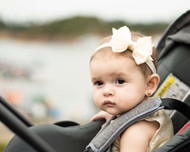Infants, particularly newborns, are the most fragile passengers that drivers can have in their car. While it is always important to drive with safety in mind, newborns have special needs that parents or guardian must take care of before and during any road trip. When a newborn comes home from the hospital, its size and slight body weight place it at risk of severe and life-threatening injury in the event of an accident. Parents must be prepared to shuttle newborns in their vehicles by first properly installing the right type of car seat. For newborns, the correct type of car seat is one that is rear-facing. As the name suggests, a rear-facing car seat is one that is designed so that the infant faces the rear of the vehicle. Infant seats are most popular for newborns, as they can be taken out of the car and carried without waking a sleeping baby, but convertible car seats, which remain in the vehicle and can be positioned rear-facing, can also be used with infants. In addition to having the right seat, drivers must also install it in the correct location. Infants, like other children, must travel in the back seat of the vehicle, preferably in the center position. The seat must be securely strapped into place in accordance with the instructions provided by the manufacturer. The baby must be strapped in securely, too, as newborns do not have the muscle control or strength to prevent them from being jostled about or to hold their heads and bodies upright.
WebMD offers tips on keeping a baby safe in the parenting guide section of their website. The five-page article talks about car safety, avoiding falls, fire safety and smoking, accidents, and bathing.
Infant Safety: Preventing Accidents
Learn about how to protect a baby from harm in the car and in other situations with advice from Sutter Health.
The Hospital for Sick Children offers parents information about how to keep kids safe including how to hold a baby, car seat safety, why not to shake a baby, preventing falls, and not leaving a baby by themselves or alone with a pet.
Car Seats: Information for Families
In a vehicle, a child's safety depends on the proper use of a child seat. Healthy Children has a comprehensive article that covers the types of car seats and how to use them in a way that maximizes a child's safety.
Putting Your Newborn in a Car Seat? 95 Percent of People Do it Wrong
According to one study involving 291 parents, only five percent properly handled the task of installing seats and properly placing their babies.
Child Passenger Safety, Infant Ages Birth to One Year
Ten children under 12 months old are injured every week in vehicle accidents, according to the New York State Department of Health. Learn how to reduce the risk of injuries here.
Visit the Children's Hospital of Philadelphia's website for tips about choosing the right car to maximize a child's safety in the event of an accident.
Six Dangerous Driving Mistake Moms Make
Distractions, cell phone use, fatigue, and difficulty with installing child safety seats are some of the many problems that Parents Magazine says mothers face while driving.
Click this link for an article about what nursing mothers should bring when traveling, what to wear, what to do when flying, and more.
What to Do When Your Baby Hates His Car Seat
Babies may find their ride in a car seat unpleasant for any number of reasons. Today's Parent provides some insight to visitors about what to do in these situations.
Are There Any Tricks to Traveling With a Breastfed Baby?
La Leche League International explains how to make the best of taking a baby on long car trips or flights.
Baby on Board: A Car Buying Guide for New Parents
Autotrader talks on their website about four criteria for choosing the right kind of family car for a baby.
Take a Road Trip With Your Baby
Carrying a baby on a long trip requires planning. The Child Development Institute talks about how to prepare for a more enjoyable journey for parents and baby alike.
How to Help Infants Sleep During a Road Trip
USA Today offers step-by-step advice on how to make a road trip a relaxing event even with a baby in tow.
Parents are required to have a proper child safety seat in order to take their baby home from the hospital.
Parents with babies can learn about what to take on a long trip away from home, when to travel, and car safety on the National Childbirth Trust's website.
How to Install a Rear-Facing Infant Car Seat
Find step-by-step instructions here to install an infant car seat.
Car Seat Safety: Ten Common Mistakes
Visit the Mayo Clinic website to see an article about mistakes that parents make regarding child car seat safety.
Newborns Shouldn't Be in a Car Seat for More Than 30 Minutes, New Research Says
Good Housekeeping explains the suffocation risk that infants face while in car seats for too long. The article advises against taking babies on long trips.
New Baby Sometimes Means New Car
Cars.com offers information about how to choose a new car that's suitable for carrying babies and their car seats, which can be a problem if you need to fit three child safety seats in at once.
Five Ways to Keep Your Infant Safe in the Car
Visit the Consumer Reports website for a news article about car seat safety tips.
Five Tips to Keeping Your Infant Content in the Car
While driving, a fussy baby can be a trying experience for parents, but these tips can make it easier.
Traveling With a Newborn to Eight-Month-Old
BabyCenter features an in-depth article about what to do when taking a baby on long-distance trips.
New Baby? Five Driving Habits to Make Immediately
Parents can make mistakes that endanger themselves and their children while driving. This article explains what these mistakes are and how to avoid them.
Warning Over Babies Sleeping in Car Seats
On this page, visitors can read about a study on infants and whether sleeping in car seats is safe. The page reviews who did the research, what kind of research it was, and the results.
- What type of car seat is safest for newborns?
- A rear-facing car seat is safest for newborns as it provides the best protection in the event of an accident.
- Where should a newborn's car seat be installed in the vehicle?
- The car seat should be installed in the back seat of the vehicle, preferably in the center position for optimal safety.
- Why is it important to securely strap in a newborn in the car seat?
- Newborns lack the muscle control to prevent themselves from being jostled, making secure strapping essential for their safety.
- Can parents use convertible car seats for infants?
- Yes, convertible car seats can be used for infants if they are positioned rear-facing.
- What common mistake do parents make with car seats?
- A study showed that 95 percent of parents improperly install car seats or place their babies incorrectly in them.





